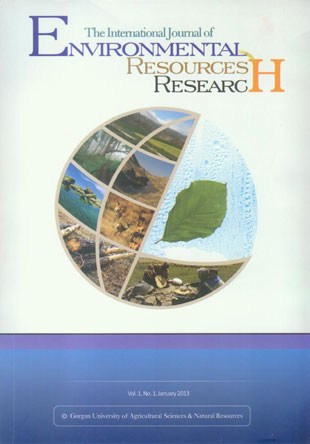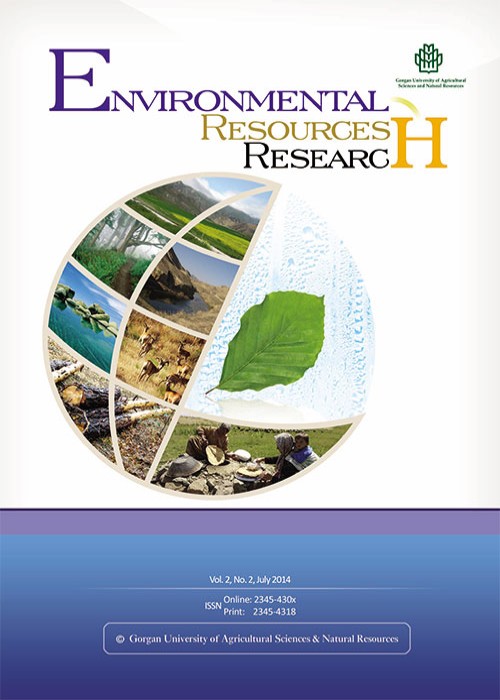فهرست مطالب

Journal of Environmental Resources Research
Volume:1 Issue: 1, Summer - Autumn 2013
- تاریخ انتشار: 1392/01/25
- تعداد عناوین: 7
-
-
Pages 1-16Addressing environmental management problems at catchment scales requires an integrated modelling approach, in which key bio-physical and socio-economic drivers, processes and impacts are all considered. Development of Decision Support Systems (DSSs) for environmental management is rapidly progressing. This paper describes the integration of physical, ecological, and socio-economic components in a Bayesian Decision Network (BDN) and its implementation in the Interactive Component Modelling System (ICMS) software to build a prototype DSS for salinity management in the Little River catchment in the upper Macquarie River basin, NSW Australia. Salinity is a major environmental problem in the country. This integrated model implemented in a DSS has been developed to co-ordinate the various disciplines involved in salinity problems, integrate data and information available, and allow the investigation of the potential outcomes arising from implementing salinity management options at the catchment scale. The analysis of the trade-offs presented in this study shows that there is no single or ultimate solution to salinity management problems for the catchment, but the Little River catchment BDN decision support system, as a decision toolbox, does clarify the impacts of management options. It assists users to reach their own conclusions on the basis of their improved understanding of the system and of the trade-offs among various outcomes arising from implementing salinity management scenarios.Keywords: Bayesian networks, Decision support system, Salinity management, The Little River catchment
-
Pages 17-29The study comparatively assessed the impacts of farm activities on the abundance and diversity of soil arthropods and soil physico-chemical parameters of the Practical Year Training Programme (PYTP) farmlands, University of Ibadan, South Western Nigeria. Soil arthropods were collected from September, 2010 to February, 2011 in five sampling sites of PYTP farmlands using BerleseTullgren Extraction method. Soil physico-chemical parameters were determined by standard procedures. A total of 19 orders of soil arthropods were obtained. Acari and Collembola accounted for the most abundant order while the Neuropterans were the least in abundance.Sites 1 and 4 (control) recorded the highest diversity (Shannon Wiener index) values of 1.88 and 1.96 respectively while site 5 recorded the highest equitability value. The ANOVA result showed no significant difference in the values of the different parameters across the sites (P>0.05). Chi-square test showed a significant association between the number of soil arthropods and the parameters of the five sampling sites. Pearson’s correlation coefficient (r) revealed a positive significant relationship between soil moisture content and the Collembolans and a negative significant relationship with Coleopterans.This study revealed a reduction in the abundance and diversity of soil arthropods in the PYTP farmlands due to consistent agricultural activities that impact the environment. Sustainable farming practices should be adopted so as to ameliorate the impact of cultivation practices on soil organisms and restore the integrity of the soil ecosystem.Keywords: Abundance, Diversity, Soil arthropods, Physico, chemical parameters, PYTP farmlands
-
Pages 30-38The rehabilitation of sandy desertified land in various dryland ecosystems by different management practices has a great potential to increase aggregate stability and improve soil quality. However, plants in general may have a different ability to sustain soil. The objective of this study was to determine the effects of practices including Haloxylon ammodendron and Atriplex canescens plantation on some soil properties, soil erodibility and the relationships between soil properties and erodibility index in desertified land of Jupar in Kerman Province, South East of Iran. According to the research objectives, 24 soil samples from 0-20 cm depth were taken from each area, i.e. reclamation sites and control area (untreated land) using a systematic – random method. Soil properties such as soil texture, structure, pH, EC, CaCO3, gypsum, bulk density, organic carbon and soil organic matter were measured. The mean weight diameter (MWD) and geometric mean diameter (GMD) were used as soil erodibility indices. The results of our study showed that MWD had positive correlation with organic carbon, CaCO3 and soil acidity values. Furthermore, according to the effect of Haloxylon on aggregate stability and its positive role in modifying soil physical and chemical properties, and also the height of this species, which can contribute to wind erosion control in this area, we conclude that Haloxylon ammodendron has better performance in desert rehabilitation and sandy land stabilization in Jupar area than Atriplex canescens.Keywords: Atriplex, Haloxylon, Soil erodibility, Mean weight diameter, Geometric mean diameter, Biological practices
-
Pages 39-50Beneficial Management Practices (BMPs) are important measures for reducing agricultural non-point source (NPS) pollution. However, selection of BMPs for placement in a watershed requires optimizing available resources to maximize possible water quality benefits. Due to its iterative nature, the optimization typically takes a long time to achieve the BMP tradeoff results which is not desirable in practice. In this study, an optimization model, consisting of a multi-objective genetic algorithm, ε-NSGA-II, in combination with the Soil Water and Assessment Tool (SWAT) and the parallel computation technique, is developed and tested in the Fairchild Creek watershed in southern Ontario of Canada. The two objectives are to minimize BMPs costs and maximize total phosphorous load reduction. The parallel computation allows the run of multiple SWAT models simultaneously and can reduce the ε-NSGA-II optimization time significantly to achieve the objective. The Pareto-optimal fronts generated between the two objective functions can be used to achieve desired water quality goals with minimum BMP implementation cost to support spatial watershed management and policy making.Keywords: Agricultural BMPs, ε NSGA, II, Parallel computation, Spatial optimization, SWAT
-
Pages 51-64Information on water changes in the hydrological systems, in time and space, as an environmental issue is vital for managers and decision makers of the watersheds and river engineers. This information can be obtained using spatially distributed modeling. In this study, simulation of water balance components in Taleghan mountainous watershed is performed using the spatially distributed hydrological model, WetSpa. This area is located on south east of Alborz range in Iran with a mean annual precipitation of 591 mm, mean slope of 40.48%, and mean elevation of 2750 m. The model implementation is based on grids of 85 m pixel size and daily temporal resolution. Through application of the spatial parameters derived from three base digital maps and daily time series data as model inputs, peak discharges and flow hydrographs are predicted at any point of stream network and spatial distribution of water balance components and hydrologic characteristics are simulated. The simulated and observed hydrographs are compared using statistical and visual methods. The results revealed a very good agreement between simulated and observed data. Considering model outputs and accuracy of 83.5% based on the Nash-Sutcliffe efficiency criterion and the Aggregated Measure of 85.6%, performance of the model is assessed as very good, hence a good reproduction of stream flow and other hydrological processes. The model thus calibrated provides users with the ability of analyzing watershed hydrology response to land use/cover change.Keywords: Spatially distributed hydrologic model, WetSpa, Water balance components, Taleghan watershed
-
Pages 65-88The statistical period from 1951 to 2005 was chosen in this research for determining the extent of influence on precipitation and annual temperature from sunspots. This analysis was conducted on 31 synoptic stations in Iran. Initially, the Mann-Kendall test was administered in order to analyze the trend of alterations of these two components over time and the results suggest that 16% of the stations show significant relationship with annual precipitation (positive and negative). More stations showed significant relationships between sunspots and minimum annual temperature (74.19%), maximum annual temperature (48.38%) and mean annual temperature (67.8%). The amounts of the above correlations include all of the significant trends, whether those that show inverse significant trends or those that demonstrate direct significant trends. For further investigating the relationship between variations in the number of sunspots and temperature, 5 temporal ranges were used. This analysis was conducted on raw data (without a moving average) and also on data with a moving average of 5, 8, 11 and 22 years. The general conclusion drawn from different temporal ranges of precipitation data was that a significant amplification for Iran’s stations with a frequency coefficient of 25.16% was observed. However, when this relationship is reversed, the frequency the coefficient turned out to be 12.92.Likewise, for different components of temperature, the inverse relationship between the number of sunspots and alterations of temperature possesses a higher frequency position among the stations. This value is 15.46 % for the minimum temperature, 16.12% for the maximum and 12.89% for the annual average temperature.Keywords: Climate change, Sunspots, Mann, Kendall test, Moving average, Iran
-
Pages 88-105SLEUTH is a cellular automata (CA) model that has been successfully applied worldwide over the last 15 years to simulate land use change. The objective of this paper is to review the current status of the SLEUTH land use change model. Clarke et al. (2007) and Clarke (2008a) provided detailed reviews of the model and its application from its initial days until about 2005.This paper brings the debates, modifications and applications of the model up to date, and provides a brief discussion of past SLEUTH applications. We next highlight the technical modifications published after 2005 and provide a detailed review of applications published until 2012. Structurally, first this paper presents a brief history and description of the SLEUTH model, and then reviews the recent successful technical modifications and applications.Keywords: SLEUTH, Cellular automata, Land use, Cover change, Modeling


